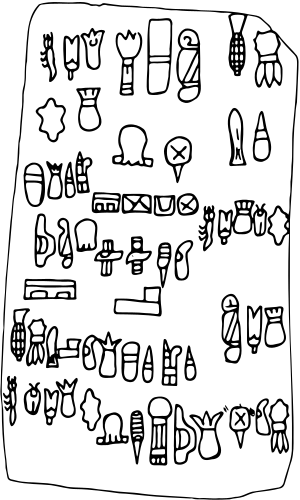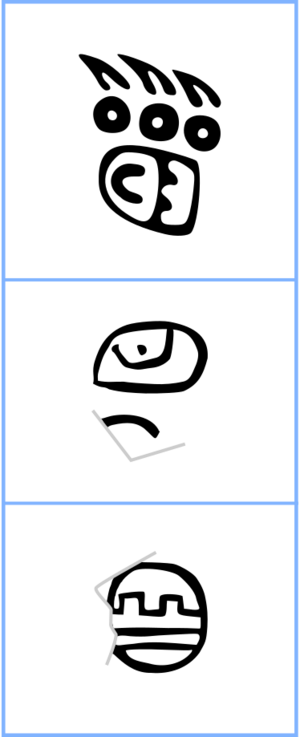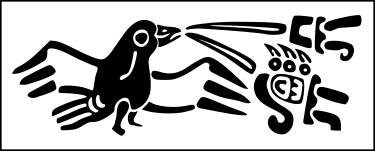Olmec hieroglyphs facts for kids
The Olmec hieroglyphs are a possible early writing system used by the ancient Olmec people. The Olmecs were one of the first major civilizations in Mesoamerica, a region that includes parts of modern-day Mexico and Central America. They lived in the tropical lowlands of what is now Veracruz and Tabasco, Mexico, from about 1500 BCE to 400 BCE.
After the Olmecs, another culture called the Epi-Olmec culture developed its own complete writing system, known as the Isthmian script. Scientists have long debated whether the Olmecs had a true writing system or just early forms of symbols. Evidence includes some individual symbols and a special stone called the Cascajal Block, which might have text on it. Also, later Mesoamerican cultures had similar calendar and writing systems, suggesting the Olmecs might have influenced them.
Contents
When Did Olmec Writing Appear?
What is the Cascajal Block?

In 2006, scientists announced the discovery of the Cascajal Block. This stone block, about the size of a writing tablet, has 62 unique symbols carved into it. Locals found it in the Olmec heartland. Archaeologists believe it dates back to around 900 BCE.
If this date and the block's authenticity are confirmed, it would be the oldest writing found in Mesoamerica. However, the symbols on the Cascajal Block are different from any other known Mesoamerican writing, like the Mayan or Isthmian script. The symbols also seem to be in horizontal rows, and they don't show a clear overall organization. It's like they are separate pieces of information.
Scientists are still studying the Cascajal Block. If it is a script, it doesn't seem to have led to later writing systems.
Did the Olmecs Use Place Names in Their Art?
All Mesoamerican writing systems use "toponyms." These are symbols or images that represent places. They combine different elements to create meaning, but they don't directly spell out sounds.
Olmec art from the Middle Formative period (900-500 BCE) shows these kinds of place names. However, experts still discuss whether these symbols are true writing that records spoken language. Some possible examples include symbols from Oxtotitlán Cave in Guerrero, a carved greenstone axe, and a tablet from Ahuelican.
What Are the Potential Olmec Symbols?
For a long time, many symbols on large Olmec sculptures were thought to be early Olmec writing. If writing means:
- Pictures that show language.
- Separate from the object they refer to.
- Arranged in lines that can become more complex.
Then, true writing might have first appeared in Mesoamerica between 600 and 500 BCE. An example is La Venta Monument 13, also known as the "Ambassador Monument."
Besides large sculptures, possible symbols have been found on smaller items like axes (like the Humboldt Celt from about 450 BCE) and pottery pieces. However, many of these symbols are clearly just pictures or designs, not writing. To know if they record spoken language, we need to see multiple symbols used together.
In 2002, a group of symbols found at San Andres was studied. During excavations in 1997 and 1998, archaeologists found three items that many believe show the Olmecs had a real writing system. These items, from around 650 BCE, were found in a trash pile from a festival. This suggests that writing among the Olmecs was special and connected to religious events.
The most important find was a ceramic cylinder seal, about the size of a fist. It was probably used to print designs on cloth. When rolled out, the seal shows two speech scrolls coming from a bird. Next to them are symbols that have been interpreted as "king," "3" (using the Mesoamerican dot and bar numbering system), and "Ajaw" (from the sacred 260-day calendar). "Ajaw" was a calendar date and also the name of an Olmec ruler.
Two small pieces of a greenstone plaque were also found, each with a carved symbol. Both of these symbols are similar to well-known symbols in other Mesoamerican writing systems, like the Isthmian and Maya scripts.
Some experts, like archaeologist Michael D. Coe, believe the San Andres symbols are "an early kind of writing." Richard A. Diehl, another archaeologist, thinks this discovery proves Olmec writing and calendars existed by 650 BCE. However, other experts, like David Stuart, say it's hard to be sure about a writing system from just a few symbols. The discovery of the Cascajal Block in 2006 made the question even more complex, as its symbols are very different from those at San Andres. More research is needed to understand these symbols.
Other possible examples of Olmec writing include a cylinder seal from Tlatilco and another from Chiapa de Corzo, Mexico. These were found during a time when the Olmec culture had a strong influence.
What is Epi-Olmec or Isthmian Script?

A few Epi-Olmec artifacts found in the Isthmus of Tehuantepec show an early Mesoamerican writing system. This system might have come from the Olmec hieroglyphs, but scientists haven't found enough Olmec writing to confirm this link.
The longest texts in this system are on La Mojarra Stela 1 and the Tuxtla Statuette. This writing system is very similar to the Maya script, using special symbols and Long Count dates. However, it is read one column at a time, like the Zapotec script. An Epi-Olmec stone from Chiapa de Corzo has the oldest date carved into a monument in the Americas: 36 BCE. A pottery piece from Chiapa de Corzo, dated to 300 BCE, was thought to be the oldest example of this writing system.
In 1997, John Justeson and Terrence Kaufman suggested they had figured out the Epi-Olmec script. But the next year, Stephen Houston and Michael D. Coe challenged their idea. They tried to use Justeson and Kaufman's system on a newly found mask with Epi-Olmec script, but it didn't work. So, the debate continues.
Images for kids
-
Detail showing symbols from the 2nd century CE La Mojarra Stela 1. The left column shows a date of 162 CE. The other columns are symbols from the Epi-Olmec script.




